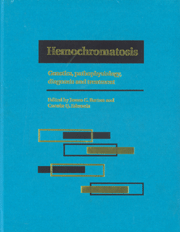Book contents
- Frontmatter
- Contents
- List of contributors
- Foreword
- Part I Introduction to hemochromatosis
- Part II Genetics of hemochromatosis
- Part III Metal absorption and metabolism in hemochromatosis
- Part IV Diagnostic techniques for iron overload
- Part V Complications of iron overload
- Part VI Therapy of hemochromatosis and iron overload
- Part VII Infections and immunity in hemochromatosis
- Part VIII Hemochromatosis heterozygotes
- Part IX Relationship of hemochromatosis to other disorders
- Part X Animal models of hemochromatosis and iron overload
- Part XI Screening for hemochromatosis
- 50 Screening tests for hemochromatosis
- 51 Cost-effectiveness of screening for hemochromatosis
- Part XII Hemochromatosis: societal and ethical issues
- Part XIII Final issues
- Index
51 - Cost-effectiveness of screening for hemochromatosis
from Part XI - Screening for hemochromatosis
Published online by Cambridge University Press: 05 August 2011
- Frontmatter
- Contents
- List of contributors
- Foreword
- Part I Introduction to hemochromatosis
- Part II Genetics of hemochromatosis
- Part III Metal absorption and metabolism in hemochromatosis
- Part IV Diagnostic techniques for iron overload
- Part V Complications of iron overload
- Part VI Therapy of hemochromatosis and iron overload
- Part VII Infections and immunity in hemochromatosis
- Part VIII Hemochromatosis heterozygotes
- Part IX Relationship of hemochromatosis to other disorders
- Part X Animal models of hemochromatosis and iron overload
- Part XI Screening for hemochromatosis
- 50 Screening tests for hemochromatosis
- 51 Cost-effectiveness of screening for hemochromatosis
- Part XII Hemochromatosis: societal and ethical issues
- Part XIII Final issues
- Index
Summary
Introduction
Hemochromatosis is an inherited disease characterized by excessive absorption of dietary iron leading to progressive tissue iron accumulation and ultimately organ damage. Early diagnosis and appropriate management can prevent disease manifestations. The high prevalence of this disorder makes it a logical target for routine screening. Hemochromatosis is generally viewed as a relatively uncommon disorder. However, several recent studies estimate its prevalence to be 3–8 per 1000, making it one of the most common genetic disorders. These high prevalence figures have been derived largely by screening asymptomatic individuals using serum transferrin saturation (TS), serum ferritin (SF) concentrations, or a combination of these tests. Hemochromatosis is an autosomal recessive disorder, the gene for which is linked to the histocompatibility (HLA) loci on the short arm of chromosome 6. Recently, a single amino acid mutation (C282Y) in a gene on chromosome 6, designated HFE, has been described, and appears to account for approximately 83% of cases of hemochromatosis. Another 4% of affected individuals are compound heterozygotes for the C282Y mutation and for another mutation in the same gene (H63D). The mechanism by which these mutations result in iron overload is unclear (see Fig. 51.1).
Hemochromatosis has been defined as homozygosity for the mutant allele. With the description of the HFE gene, it is clear that there may be genetic defects that result in iron overload in some cases. Persons homozygous for the hemochromatosis allele(s) do not have increased iron stores early in life.
- Type
- Chapter
- Information
- HemochromatosisGenetics, Pathophysiology, Diagnosis and Treatment, pp. 525 - 532Publisher: Cambridge University PressPrint publication year: 2000
- 1
- Cited by



